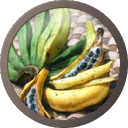Interspecific introgression patterns reveal the origins of worldwide cultivated bananas in New Guinea.
Summary
| Abstract | Hybridizations between Musa species and subspecies, enabled by their transport via human migration, were proposed to have played an important role in banana domestication. We exploited sequencing data of 226 accessions, including wild and cultivated Musa diversity, to characterize the inter-(sub)-specific hybridization pattern that gave rise to cultivated bananas. We identified 11 genetic pools that contributed to cultivars, including two contributors of unknown origin. Informative alleles for each of these genetic pools were pinpointed and used to obtain genome ancestry mosaics of accessions. Diploid and triploid cultivars had genome mosaics involving three up to possibly seven contributors. The simplest mosaics were found for some diploid cultivars from New Guinea, combining three contributors, i.e. banksii and zebrina representing M. acuminata subspecies and, more unexpectedly, the New Guinean species M. schizocarpa. Breakpoints of M. schizocarpa introgressions were found to be conserved between New Guinea cultivars and the other analysed diploid and triploid cultivars. This suggests that plants bearing these M. schizocarpa introgressions were transported from New Guinea and gave rise to currently cultivated bananas. Many cultivars showed contrasted mosaics with predominant ancestry from their geographical origin across Southeast Asia to New Guinea. This revealed that further diversification occurred in different Southeast Asian regions through hybridization with other Musa (sub)-species, including two unknown ancestors that we propose to be M. a. ssp. halabanensis and a yet to be characterized M. acuminata ssp. These results highlighted a dynamic crop formation process that was initiated in New Guinea, with subsequent diversification throughout Southeast Asia. | ||
|---|---|---|---|
| Publication Date | 2022 Dec 28 | ||
| DOI | 10.1111/tpj.16086 | ||
| Cross Reference |
| ||
| Citation | Martin G, Cottin A, Baurens FC, Labadie K, Hervouet C, Salmon F, Paulo-de-la-Reberdiere N, Van den Houwe I, Sardos J, Aury JM, D'Hont A, Yahiaoui N. Interspecific introgression patterns reveal the origins of worldwide cultivated bananas in New Guinea.. The Plant journal : for cell and molecular biology. 2022 Dec 28. |





